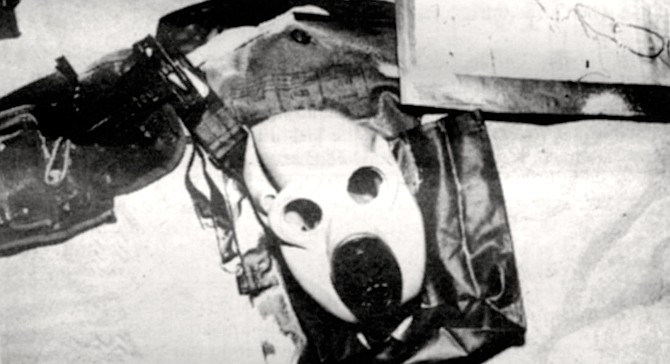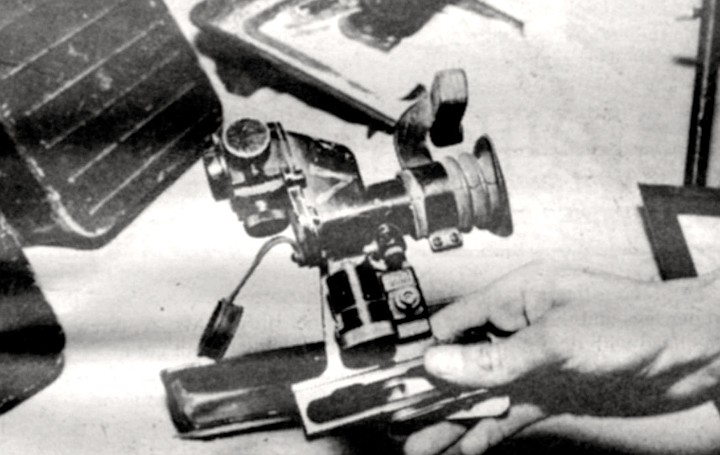 Facebook
Facebook
 X
X
 Instagram
Instagram
 TikTok
TikTok
 Youtube
Youtube

Before leaving the Kuwaiti desert. Camp Pendleton Marines collected enough war trophies to field a small army — everything from automatic rifles to Soviet-built tanks — and brought them stateside.

Camp Pendleton was the staging point for the First Marine Expeditionary Force during the Gulf War. The First Marines fought back attacking Iraqi forces at Khafji and led the thrust into Iraqi-occupied Kuwait.

According to Pendleton's Gunnery Sergeant John Farrell, Marine Corps units are authorized to bring home items of historical significance. Among the Iraqi hardware that has already arrived at Pendleton are an Iraqi ZSU-23-4 self-propelled anti-aircraft cannon, a D-20 howitzer, a Soviet-made T-72 tank, an armored personnel carrier, a Chinese-made 55mm mortar, two Soviet 60mm mortars, an 82mm mortar, two rocket-propelled grenade launchers, and an 85mm anti-aircraft gun. The hardware is part of the SK) billion worth of weapons Iraq purchased from the Soviets between 1980 to 1987.
Some of the armored vehicles might have been captured in the battle for Khafji, a seaside Saudi town overrun by Iraqi forces shortly before the push to liberate Kuwait began. Other equipment was probably captured during the drive into Kuwait.
More hardware is still on the way. "The stuff is still coming into our railroad depot on flatcars." said Pendleton's Farrell, who added that the weapons' historical significance has yet to be determined by the base historian.
The U.S. Marine Corps Command Museum at the Marine Corps Recruit Depot off Pacific Highway displays dozens of these personal war mementos. Among the items donated by various Marines are a complete Iraqi uniform, three Iraqi flags taken from captured bunkers, a Kuwaiti flag, propaganda and surrender leaflets from both sides, and an Iraqi gas mask.
More than 20 different kinds of leaflets were dropped by American soldiers onto Iraqi lines. According to Gunnery Sergeant Sharon Piseno, “because [the Iraqis] are such religious people, most of [the pamphlets] were written to affect them religiously." Countering Saddam Hussein's claims that the allies would torture captured soldiers, the leaflets promised Iraqi soldiers good treatment and freedom to practice their religion. Thirteen kinds of leaflets were dropped on U.S. troops. One showed a Scud missile aimed at the head of a U.S. soldier, promising that such a fate would befall GIs if they did not surrender.
Also on display are a series of photographs showing an Iraqi tank unit surrendering. The photos were donated by the commander of a Marine tank unit that became lost in a sandstorm in the early hours of the ground war. When the storm finally lifted, the Leathernecks found themselves nose-to-nose with an entire Iraqi tank battalion. The outgunned Marines braced themselves for a firefight. but in moments they were overrun — by surrendering Iraqis.
The museum display features a Soviet-made 81mm mortar and a number of AK-47 assault rifles, including models manufactured in the USSR. Yugoslavia, and Iraq. The rifles are quite unusual. Piseno said, because “the Iraqis do strange things to their weapons." Iraqi soldiers modify their rifles by sawing off the barrel at a 45-degree angle. This changes the velocity of the bullet, giving it more power at shorter ranges. They also replace the standard-issue wooden stock with a folding metal stock, making the rifle easier to carry. Names and religious symbols are often engraved on their weapons.
In the high desert of Riverside County, the Marine base at Twentynine Palms has also received shipments of war trophies. Among them are three different types of Soviet-built, desert-tan colored Iraqi tanks, an armored personnel carrier, a command trac (like a mobile command center), a tank retriever (similar to a tow truck for a battle-damaged tank), and a quad (four-barrel) anti-aircraft gun.
A third display sits on the quarterdeck of the U.S.S. Tripoli. The Tripoli's crew put together an Iraqi floating mine to commemorate their service in the Persian Gulf. Photographs of the amphibious assault ship's mine-sweeping operations are displayed along with some Iraqi small arms. But it's the jagged, twisted steel next to the floating mine that holds the most significance for the ship's crew.
While the Tripoli was sweeping for mines off the Kuwaiti coast, an Iraqi mine tore a gaping hole in her side. Many of her compartments were flooded, and toxic fumes from a shattered paint locker spread throughout the below-deck areas. Damage-control parties battled the water that rushed through the hole. The crew shored up the damage and kept the hull from buckling further. Their efforts not only kept the Tripoli afloat but allowed the ship to continue her sweeping activities until she was able to put into Bahrain for repairs.


Before leaving the Kuwaiti desert. Camp Pendleton Marines collected enough war trophies to field a small army — everything from automatic rifles to Soviet-built tanks — and brought them stateside.

Camp Pendleton was the staging point for the First Marine Expeditionary Force during the Gulf War. The First Marines fought back attacking Iraqi forces at Khafji and led the thrust into Iraqi-occupied Kuwait.

According to Pendleton's Gunnery Sergeant John Farrell, Marine Corps units are authorized to bring home items of historical significance. Among the Iraqi hardware that has already arrived at Pendleton are an Iraqi ZSU-23-4 self-propelled anti-aircraft cannon, a D-20 howitzer, a Soviet-made T-72 tank, an armored personnel carrier, a Chinese-made 55mm mortar, two Soviet 60mm mortars, an 82mm mortar, two rocket-propelled grenade launchers, and an 85mm anti-aircraft gun. The hardware is part of the SK) billion worth of weapons Iraq purchased from the Soviets between 1980 to 1987.
Some of the armored vehicles might have been captured in the battle for Khafji, a seaside Saudi town overrun by Iraqi forces shortly before the push to liberate Kuwait began. Other equipment was probably captured during the drive into Kuwait.
More hardware is still on the way. "The stuff is still coming into our railroad depot on flatcars." said Pendleton's Farrell, who added that the weapons' historical significance has yet to be determined by the base historian.
The U.S. Marine Corps Command Museum at the Marine Corps Recruit Depot off Pacific Highway displays dozens of these personal war mementos. Among the items donated by various Marines are a complete Iraqi uniform, three Iraqi flags taken from captured bunkers, a Kuwaiti flag, propaganda and surrender leaflets from both sides, and an Iraqi gas mask.
More than 20 different kinds of leaflets were dropped by American soldiers onto Iraqi lines. According to Gunnery Sergeant Sharon Piseno, “because [the Iraqis] are such religious people, most of [the pamphlets] were written to affect them religiously." Countering Saddam Hussein's claims that the allies would torture captured soldiers, the leaflets promised Iraqi soldiers good treatment and freedom to practice their religion. Thirteen kinds of leaflets were dropped on U.S. troops. One showed a Scud missile aimed at the head of a U.S. soldier, promising that such a fate would befall GIs if they did not surrender.
Also on display are a series of photographs showing an Iraqi tank unit surrendering. The photos were donated by the commander of a Marine tank unit that became lost in a sandstorm in the early hours of the ground war. When the storm finally lifted, the Leathernecks found themselves nose-to-nose with an entire Iraqi tank battalion. The outgunned Marines braced themselves for a firefight. but in moments they were overrun — by surrendering Iraqis.
The museum display features a Soviet-made 81mm mortar and a number of AK-47 assault rifles, including models manufactured in the USSR. Yugoslavia, and Iraq. The rifles are quite unusual. Piseno said, because “the Iraqis do strange things to their weapons." Iraqi soldiers modify their rifles by sawing off the barrel at a 45-degree angle. This changes the velocity of the bullet, giving it more power at shorter ranges. They also replace the standard-issue wooden stock with a folding metal stock, making the rifle easier to carry. Names and religious symbols are often engraved on their weapons.
In the high desert of Riverside County, the Marine base at Twentynine Palms has also received shipments of war trophies. Among them are three different types of Soviet-built, desert-tan colored Iraqi tanks, an armored personnel carrier, a command trac (like a mobile command center), a tank retriever (similar to a tow truck for a battle-damaged tank), and a quad (four-barrel) anti-aircraft gun.
A third display sits on the quarterdeck of the U.S.S. Tripoli. The Tripoli's crew put together an Iraqi floating mine to commemorate their service in the Persian Gulf. Photographs of the amphibious assault ship's mine-sweeping operations are displayed along with some Iraqi small arms. But it's the jagged, twisted steel next to the floating mine that holds the most significance for the ship's crew.
While the Tripoli was sweeping for mines off the Kuwaiti coast, an Iraqi mine tore a gaping hole in her side. Many of her compartments were flooded, and toxic fumes from a shattered paint locker spread throughout the below-deck areas. Damage-control parties battled the water that rushed through the hole. The crew shored up the damage and kept the hull from buckling further. Their efforts not only kept the Tripoli afloat but allowed the ship to continue her sweeping activities until she was able to put into Bahrain for repairs.
Comments